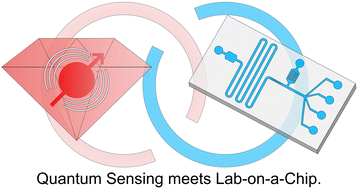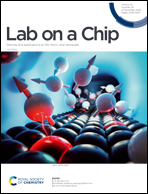Microfluidic quantum sensing platform for lab-on-a-chip applications†
Abstract
Lab-on-a-chip (LOC) applications have emerged as invaluable physical and life sciences tools. The advantages stem from advanced system miniaturization, thus, requiring far less sample volume while allowing for complex functionality, increased reproducibility, and high throughput. However, LOC applications necessitate extensive sensor miniaturization to leverage these inherent advantages fully. Atom-sized quantum sensors are highly promising to bridge this gap and have enabled measurements of temperature, electric and magnetic fields on the nano- to microscale. Nevertheless, the technical complexity of both disciplines has so far impeded an uncompromising combination of LOC systems and quantum sensors. Here, we present a fully integrated microfluidic platform for solid-state spin quantum sensors, like the nitrogen-vacancy (NV) center in diamond. Our platform fulfills all technical requirements, such as fast spin manipulation, enabling full quantum sensing capabilities, biocompatibility, and easy adaptability to arbitrary channel and chip geometries. To illustrate the vast potential of quantum sensors in LOC systems, we demonstrate various NV center-based sensing modalities for chemical analysis in our microfluidic platform, ranging from paramagnetic ion detection to high-resolution microscale NV-NMR. Consequently, our work opens the door for novel chemical analysis capabilities within LOC devices with applications in electrochemistry, high-throughput reaction screening, bioanalytics, organ-on-a-chip, or single-cell studies.

- This article is part of the themed collections: Miniaturised Sensors & Diagnostics and Lab on a Chip HOT Articles 2022


 Please wait while we load your content...
Please wait while we load your content...